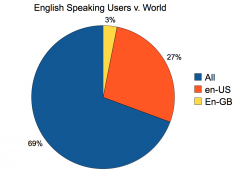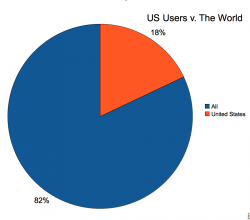L10n:WorldReady: Difference between revisions
ChrisHofmann (talk | contribs) |
No edit summary |
||
| (38 intermediate revisions by 7 users not shown) | |||
| Line 1: | Line 1: | ||
== Introduction == | |||
[[File:En-v-world.png|250px|thumb|right|English Active Daily Users v. rest of world]] | |||
[[File:Us-v-world.png|250px|thumb|right|US ADU v. rest of world]] | |||
Those that participate on the Mozilla Project can be proud of the work that first enabled 24 localized versions to ship simultaneous with Firefox 1.0, and the fact that we have grown that to over 95 localized versions available for the latest release. | |||
Those that participate on the Mozilla Project can be proud of the work that first enabled 24 localized versions to ship simultaneous with Firefox 1.0, and the fact that we have grown that to over | |||
It is pretty well understood across the project in every area of work that that users and contributors around the world are a key factor in impact we have on the Mozilla Project. | It is pretty well understood across the project in every area of work that that users and contributors around the world are a key factor in impact we have on the Mozilla Project. | ||
| Line 18: | Line 14: | ||
The "Mozilla World Ready" project is about creating greater awareness around localization issues, educating new participants to the project, and taking steps addressing these problems that limit our ability to reach and connect users around the world. Its about doing all the things that we currently do, but making things "world-ready" earlier in the development cycle to make them easier and faster to accomplish. Its about improving the quality of all our efforts across the world, in every locale, including en-US, and factoring in world wide sensibilities that will improve Firefox and the way we talk about our products and projects. | The "Mozilla World Ready" project is about creating greater awareness around localization issues, educating new participants to the project, and taking steps addressing these problems that limit our ability to reach and connect users around the world. Its about doing all the things that we currently do, but making things "world-ready" earlier in the development cycle to make them easier and faster to accomplish. Its about improving the quality of all our efforts across the world, in every locale, including en-US, and factoring in world wide sensibilities that will improve Firefox and the way we talk about our products and projects. | ||
= | == Internationliazation Training Sessions == | ||
= | |||
In 2021 we kicked off a new training sessions initiative to increase awareness and educate new participants. Training sessions happen online every other week and are recorded so if you cannot attend live you can still benefit from the initiative. | |||
Intl Training Session 1: Internationalization & Localization ([https://docs.google.com/presentation/d/16JLhtlHCaT-Po7wJZvRXkRkB0e7FJD7ykEyeuUJ6Kb8/ Slide Deck]) ([https://mozilla.hosted.panopto.com/Panopto/Pages/Viewer.aspx?id=beeb5ce4-2dbd-496d-a8bf-acb0013e0dce Video]) | |||
Intl Training Session 2: Languages, Regions, and Language Matching ([https://docs.google.com/presentation/d/1GQ2DCT-25adK2xeVxOMa0mmouPIytMOYgtg5AXlaKJM/ Slide Deck]) ([https://mozilla.hosted.panopto.com/Panopto/Pages/Viewer.aspx?id=b3c4ec0f-b518-4a4f-a4e4-acbe014d1378 Video]) | |||
Intl Training Session 3: Numbers, Units and Currencies ([https://docs.google.com/presentation/d/1oMTqJAQmo8TPxoOCMmFLTGUxhgbA6JE3IoeXltThtco/ Slide Deck]) ([https://mozilla.hosted.panopto.com/Panopto/Pages/Viewer.aspx?id=5d8d1630-0c01-4f2f-84bc-acd301428d99 Video]) | |||
Intl Training Session 4: Dates, Times, and Calendars. ([https://docs.google.com/presentation/d/1WaBtKuA0iJeNL260wVdxBIVj_2I8kv6OVL6AwwyoE_E/ Slide Deck]) ([https://mozilla.hosted.panopto.com/Panopto/Pages/Viewer.aspx?id=b861ea84-f259-429d-9dfd-ace1016bbf30 Video]) | |||
Intl Training Session 5: Input Methods ([https://docs.google.com/presentation/d/1taEFYrHrGALPFGnqgnCzESDyax1Jza4wJBR0GXwGG00/ Slide Deck]) ([https://mozilla.hosted.panopto.com/Panopto/Pages/Viewer.aspx?id=24dd8277-2704-4469-9714-acf00115b7f8 Video]) | |||
Intl Training Session 6: User Preferences - Language & Regional Settings ([https://docs.google.com/presentation/d/1taEFYrHrGALPFGnqgnCzESDyax1Jza4wJBR0GXwGG00/ Slide Deck]) ([https://mozilla.hosted.panopto.com/Panopto/Pages/Viewer.aspx?id=c87efb77-1548-4352-aa88-acfd012eb090 Video]) | |||
Latest revision as of 19:32, 1 April 2021
Introduction
Those that participate on the Mozilla Project can be proud of the work that first enabled 24 localized versions to ship simultaneous with Firefox 1.0, and the fact that we have grown that to over 95 localized versions available for the latest release.
It is pretty well understood across the project in every area of work that that users and contributors around the world are a key factor in impact we have on the Mozilla Project.
70% of Firefox users use non-English versions of Firefox, and more than 80% of Firefox users are outside of the United States.
Even though we have made great progress in the localization process and simultaneous shipping of more localized versions, to more people around the world, that than any other software development organization there are still a lot of things we can do to improve.
The "Mozilla World Ready" project is about creating greater awareness around localization issues, educating new participants to the project, and taking steps addressing these problems that limit our ability to reach and connect users around the world. Its about doing all the things that we currently do, but making things "world-ready" earlier in the development cycle to make them easier and faster to accomplish. Its about improving the quality of all our efforts across the world, in every locale, including en-US, and factoring in world wide sensibilities that will improve Firefox and the way we talk about our products and projects.
Internationliazation Training Sessions
In 2021 we kicked off a new training sessions initiative to increase awareness and educate new participants. Training sessions happen online every other week and are recorded so if you cannot attend live you can still benefit from the initiative.
Intl Training Session 1: Internationalization & Localization (Slide Deck) (Video)
Intl Training Session 2: Languages, Regions, and Language Matching (Slide Deck) (Video)
Intl Training Session 3: Numbers, Units and Currencies (Slide Deck) (Video)
Intl Training Session 4: Dates, Times, and Calendars. (Slide Deck) (Video)
Intl Training Session 5: Input Methods (Slide Deck) (Video)
Intl Training Session 6: User Preferences - Language & Regional Settings (Slide Deck) (Video)

